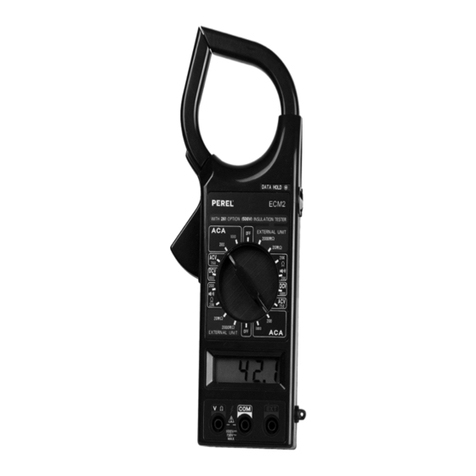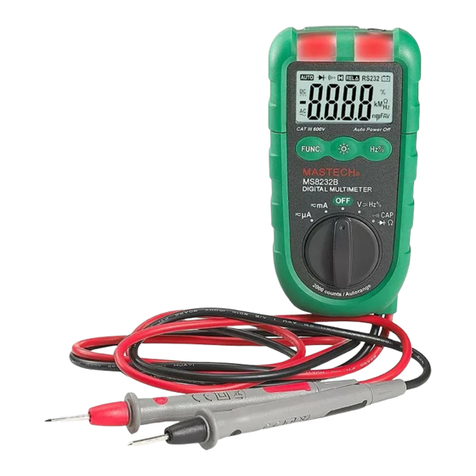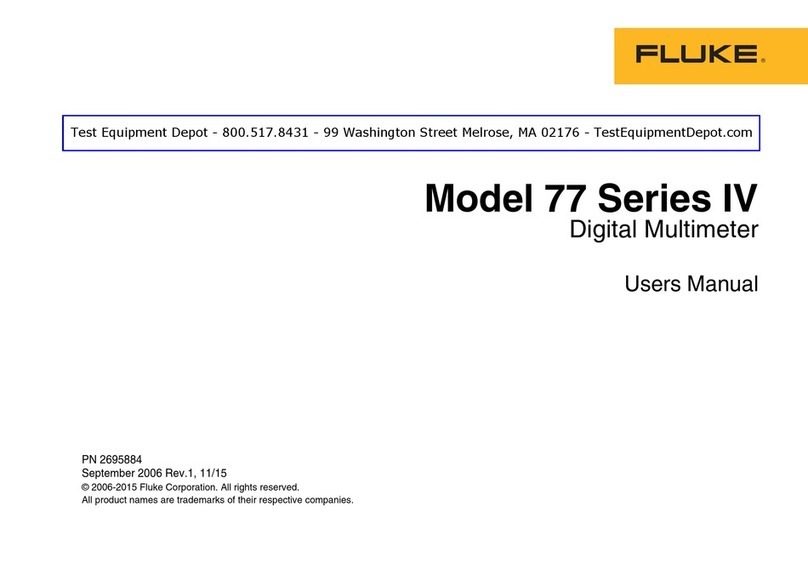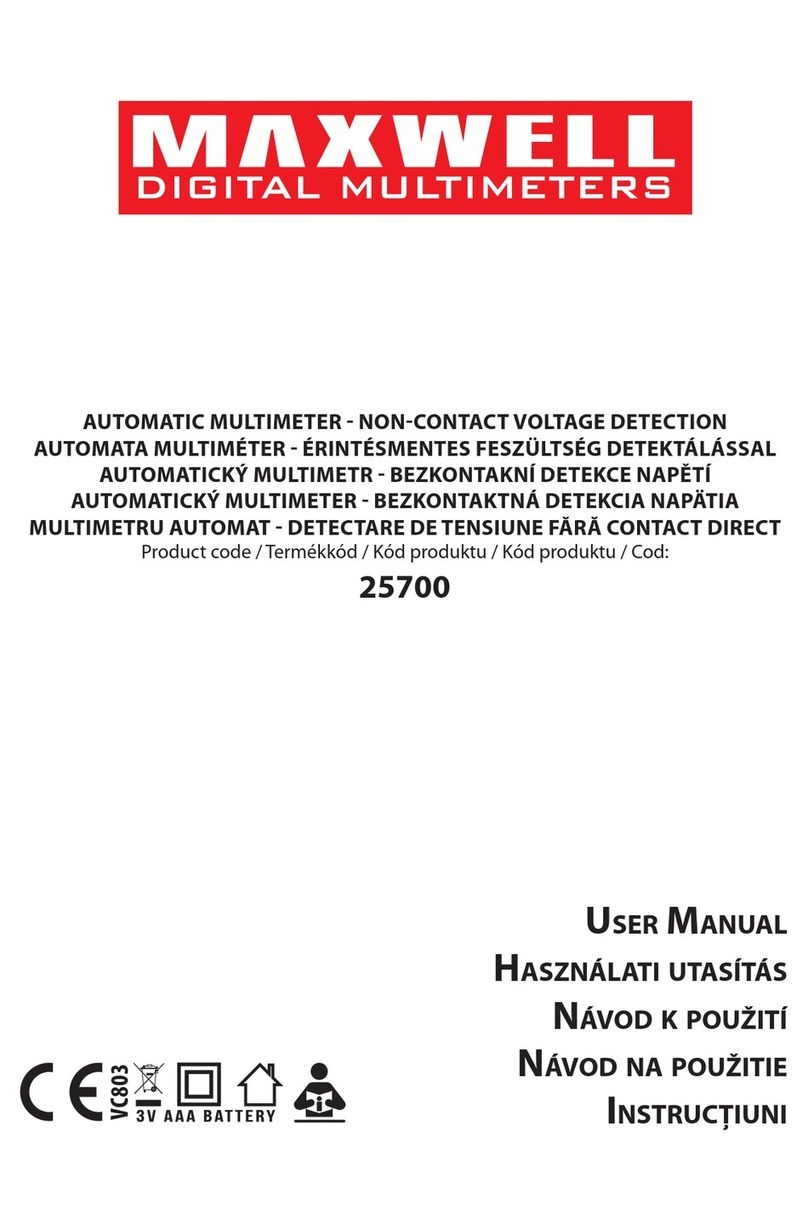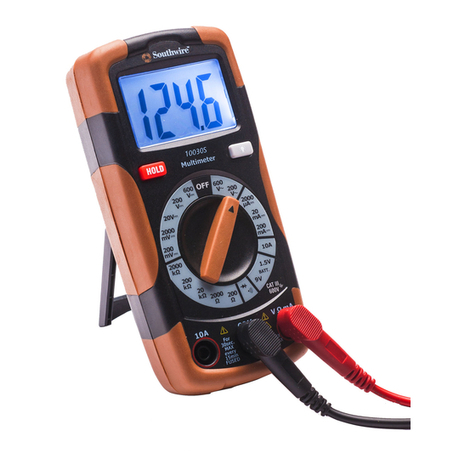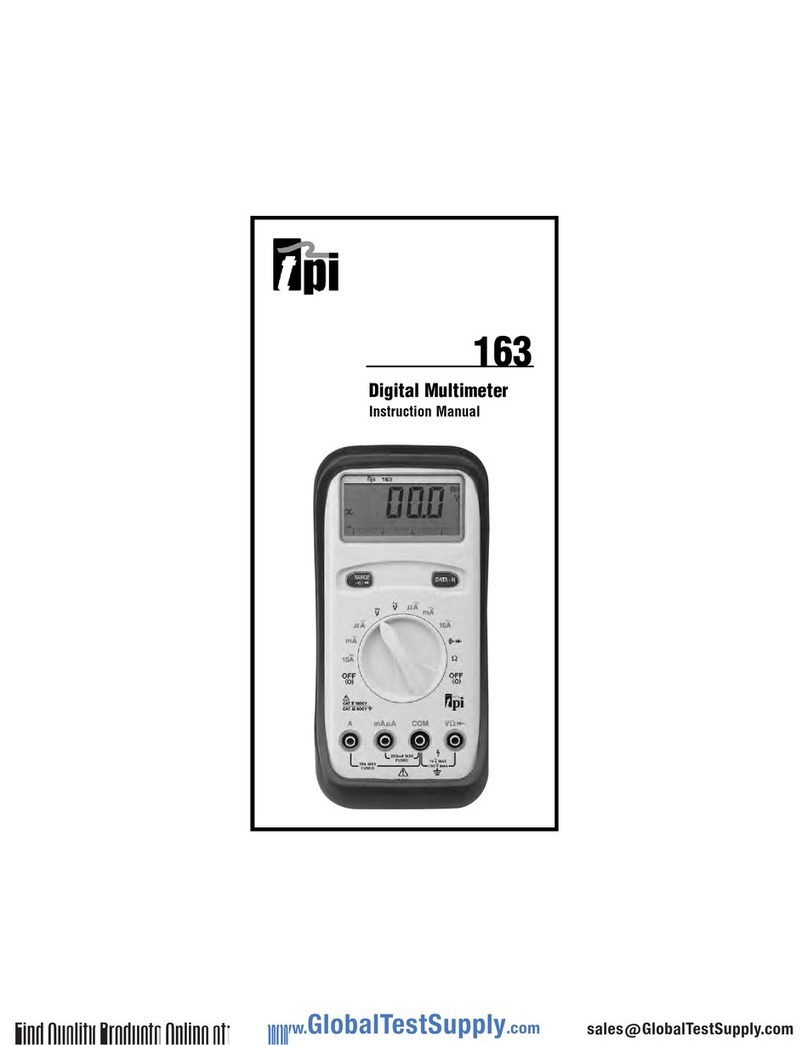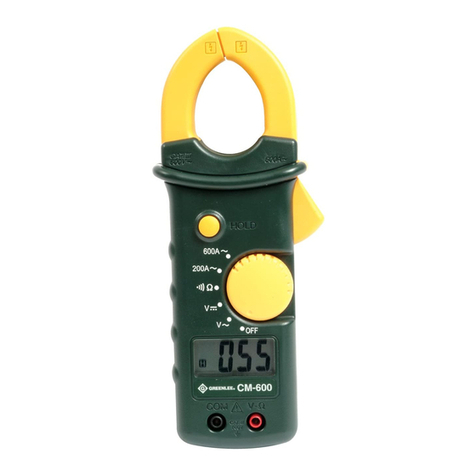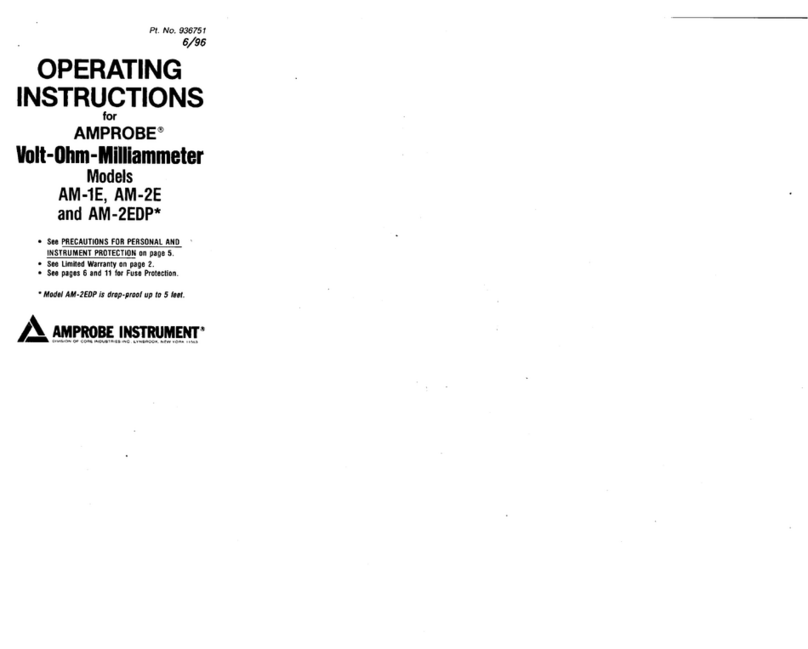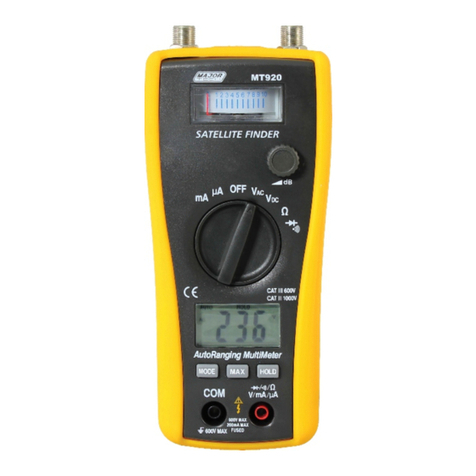Ethos 5020 User manual

1
ETHOS 5020
Auto Ranging Digital Multimeter

2
1. SAFETY INFORMATION
SAFETY SYMBOLS
Warning! Dangerous Voltage (Risk of electric shock).
Caution! Refer to the user’s manual before using this Meter.
Double Insulation (Protection Class Ⅱ).
Alternating Current (AC).
Direct Current (DC).
Either DC or AC.
Ground (maximum permitted voltage between terminal and ground).
The symbol indicating separate collection for electrical and electronic
equipment.
The RESPONSIBLE BODY shall be made aware that, if the instrument
is used in a manner not specified by the manufacturer, the protection
provided by the instrument may be impaired.
The finger or any part of your body shall not be beyond the barrier of
the test probe when measuring.
Individual protective equipment must be used if HAZARDOUS LIVE
parts in the installation where measurement is to be carried out could
be ACCESSIBLE.
The following safety information must be observed to insure maximum personal
safety during the operation at this meter.
Do not operate the meter if the body of meter or the test leads appear to be
damaged.
Check the main function dial and ensure it is at the correct position before each
measurement.
When making current measurements ensure that the circuit is not “live”
before opening it in order to connect the test leads.
Do not perform resistance, diode and continuity test on a live power system.
Do not apply voltage between the test terminals and test terminal to ground
that exceeds the maximum limit record in this manual.
Exercise extreme caution when measuring live system with voltage greater
than 60V DC or 30V AC.
Change the battery when the “ ” symbol appears to avoid incorrect data.
Use the DMM indoor, altitude up to 2000m and temperature 5℃to 40℃.
Maximum relative humidity 80% for temperatures up to 31℃, decreasing

3
linearly to 50% relative humidity at 40℃. Pollution Degree 2.
2. SPECIFICATIONS
2.1 GENERAL SPECIFICATIONS
Display: LCD with a max. reading of 1999.
Display sign of the test lead connect to socket.
Range control: Auto range & Manual range control
Polarity: Automatic negative polarity indication.
Zero adjustment: Automatic.
Over range indication: The “OL” or “-OL” display.
Low battery indication: Display " " sign.
Data hold: Display “DH” sign.
Max hold: Display “MH” sign.
Auto Power Off: When measurement exceeds 15 minutes without switching
mode and pressing key, the meter will switch to standby mode.
Press any key to exit standby mode. When restart the system,
press and hold M.H key to disable auto power off.
Safety standards: EMC/LVD. CAT Ⅲ600V.
The meter is up to the standards of IEC1010 Double
Insulation,Pollution Degree 2, Overvoltage Category Ⅲ.
Operating environment: Temperature 32° to104°F (0°C to 40°C),
Humidity ≤80% RH.
Storage environment: Temperature -4° to140°F (-20°C to 60°C),
Humidity ≤90% RH.
Fuse: F0.5AL 250V 5 x 20mm, F10AL 250V 5 x 20mm.
Power supply: 9V battery ( 6F22 ).
Test lead probe: RE10, CATⅢ600V / CATⅡ1000V, 10A, L=90cm.
Dimension: 177(H) x 92(W) x 40(D) mm
Weight: Approx. 320g (including battery).
2.2 ELECTRICAL SPECIFICATIONS
Accuracies are ± (% of reading + number in last digit)
At 23 ± 5°C ,≤75% RH.
2.2.1 DC Voltage
Range Accuracy Resolution
200mV
± ( 0.5%+2 )
0.1mV
2V 1mV
20V 10mV
200V 100mV
600V ± ( 0.8%+2 ) 1V
Overload protection: 600V DC or AC rms

4
Impedance: 10MΩ,More than 100MΩon 200mV range
2.2.2 AC Voltage
Range Accuracy Resolution
2V
± ( 0.8%+3 )
1mV
20V 10mV
200V 100mV
600V ± ( 1.2%+3 ) 1V
Average sensing, calibrated to rms of sine wave
Frequency: 40~500Hz
Overload protection: 600V DC or AC rms
Impedance: 10MΩ
2.2.3 DC Current
Range Accuracy Resolution
200µA
± ( 1.2%+2 )
0.1µA
2000µA 1µA
20mA 10µA
200mA 100µA
2A ± ( 2.0%+3 ) 1mA
10A 10mA
Overload protection: 0.5A/250V, 10A/250V fuse
Continuous testing the maximum steady-state current of 1A
2.2.4 AC Current
Range Accuracy Resolution
200µA ± ( 1.5%+3 )
0.1µA
2000µA 1µA
20mA 10µA
200mA 100µA
2A ± ( 2.5%+5 )
1mA
10A 10mA
Average sensing, calibrated to rms of sine wave
Frequency: 40~500Hz
Overload protection: 0.5A/250V, 10A/250V fuse
Continuous testing the maximum steady-state current of 1A
2.2.5 Resistance
Range Accuracy Resolution
200Ω± ( 1.0%+1Ω) 0.1Ω
2kΩ± ( 1.0%+2 )
1Ω
20kΩ10Ω
200kΩ100Ω
2MΩ1kΩ
20MΩ± (1.5%+3 ) 10kΩ

5
Overload protection: 250V DC or AC rms
2.2.6 Diode and Audible continuity test
Range Description Test condition
Display read
approximately
forward voltage
of diode
Forward DC current
approx. 1mA
Reversed DC voltage
approx. 1.5V
Built-in buzzer
sounds if
resistance is
less than 30Ω
Open circuit voltage
approx. 0.5V
Overload protection: 250V DC or AC rms
2.2.7 Battery test
Range Accuracy Load current
Resolution
1.5V ±(5.0%+5 ) 100mA 1mV
9V 5mA 10mV
Overload protection: 0.5A/250V fuse
3. OPERATION
3.1 DC Voltage Measurement
1) Connect the black test lead to "COM" socket and red test lead to the "VΩ"
socket. The LCD will display sign of the test lead connect to socket.
2) Set the selector switch to desired “V” position.
3) Measure the voltage by touch the test lead tips to the test circuit where the
value of voltage is needed.
4) Read the result from the LCD panel.
3.2 AC Voltage Measurement
1) Connect the black test lead to "COM" socket and red test lead to the "VΩ"
socket. The LCD will display sign of the test lead connect to socket.
2) Set the selector switch to desired “V” position.
3) Measure the voltage by touch the test lead tips to the test circuit where the
value of voltage is needed.
4) Read the result from the LCD panel.
3.3 DC and AC Current Measurement
1) Connect the black test lead to "COM" socket. For measurement up to
200mA, connect the red test lead to the "BATmA" socket; for measurement
from 200mA to 10A, connect the red test lead to the "10A" socket. The LCD
will display sign of the test lead connect to socket.
2) Set the selector switch to desired “µA”、“mA ” or “A” position.

6
3) Press “SELECT” key to choose “DC” or “AC” measurement.
4) Remove power from the circuit under test and open the normal circuit path
where the measurement is to be taken. Connect the meter in series with
the circuit.
5) Read the result from the LCD panel.
3.4 Resistance Measurement
1) Connect the black test lead to "COM" socket and red test lead to the "VΩ"
socket. The LCD will display sign of the test lead connect to socket.
2) Set the selector switch to desired “ ” position.
3) Connect tip of the test leads to the points where the value of the resistance
is needed.
4) Read the result from the LCD panel.
Note:
When take resistance value from a circuit system, make sure the power is cut
off and all capacitors need to be discharged.
3.5 Diode and Audible continuity Test
1) Connect the black test lead to "COM" socket and red test lead to the "VΩ"
socket. The LCD will display sign of the test lead connect to socket.
2) Set the selector switch to desired “ ” position.
3) Press “SELECT” key to choose Diode or Audible continuity measurement.
4) Connect the test leads across the diode under measurement, display shows
the approx. forward voltage of this diode.
5) Connect the test leads to two point of circuit, if the resistance is lower than
approx. 30Ω, the buzzer sounds.
Note:
Make sure the power is cut off and all capacitors need to be discharged
under this measurement.
3.6 Battery Test
1) Connect the black test lead to "COM" socket and red test lead to the
"BATmA" socket. The LCD will display sign of the test lead connect to
socket.
2) Set the selector switch to desired “1.5V” or “9V” position.
3) Connect the probe across the source or load under measurement.
4) Read the result from the LCD panel.
3.7 Data Hold
On any range, press the “D.H” key to lock display value, and the “DH” sign will
appear on the display, press it again to exit.
3.8 MAX Hold
Press the “M.H” key to lock MAX value, and the “MH” sign will appear on the

7
display, press it again to exit.
3.9 Auto/Manual range
The auto range mode is a convenient function, but it might be faster to
manually set the range when you measure values that you know to be within
a certain range.
To select manual range, repeatedly press “RANGE” key until the display
shows the desired range. The range steps upward as you press “RANGE” key.
The meter will go back to auto range mode when you press “RANGE” key for
more than 2 seconds.
Caution: while using the manual range mode, if “OL” sign appears on the
display, immediately set range to a higher.
3.10 Back Light
On any range, press the “ ” key over 2 seconds to light the back light, press
it again for more than 2 seconds to flash the light. The light can flash
automatically after 15 seconds too.
4. Battery replacement
1)
When the battery voltage drop below proper operation range, the “ ”
symbol will appear on the LCD display and the battery needs to changed.
2) Before changing the battery, set the selector switch to “OFF” position.
Open the cover of the battery cabinet by a screwdriver.
3) Replace the old battery with the same type battery.
4) Close the battery cabinet cover and fasten the screw.
Caution: Dispose the used batteries according to the rules, which are defined
by each country.
Warning: If an explosion or fire hazard could occur through fitting a battery of
the wrong type.
5. Fuse replacement
1) This meter is provided with a 0.5A/250V fuse to protect the b
attery test
and
the current measuring circuits which measure up to 200mA, with a
10A/250V fuse to protect the 10A range.
2) Ensure the instrument is not connected to any external circuit,
set
the selector switch to “OFF” position and remove the test leads from the
terminals.
3) Remove the three screws on the bottom case and lift the bottom case.
Replace the old fuse with the same type and rating:
5×20mm 0.5A/250V or 5×20mm 10A/250V fuse.
4) Close the bottom case and fasten the screws.

8
6. MAINTENANCE
1) Before open the battery cover, disconnect both test lead and never uses the
meter before the battery cover is closed.
2) To avoid contamination or static damage, do not touch the circuit board
without proper static protection.
3) If the meter is not going to be used for a long time, take out the battery and
do not store the meter in high temperature or high humidity environment.
4) Repairs or servicing not covered in this manual should only be performed by
qualified personal.
5) Periodically wipe the case with a dry cloth and detergent. Do not use
abrasives or solvents on the meter.
Distributed by MTi
Victoria Road,
Avonmouth,
Bristol,
BS11 9DB
Tel: 0117 938 6400
Fax: 0117 923 5374
Email: enquiries.ethos@adivision.co.uk
Web: www.ethos-instruments.co.uk
Table of contents
Other Ethos Multimeter manuals



